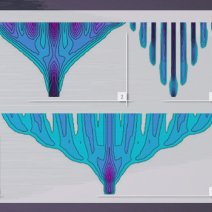Local adaptation, dispersal evolution, and the spatial eco-evolutionary dynamics of invasion.
Martin Andrade-Restrepo, Régis Ferrière, Nicolas Champagnat.
Abstract
Local adaptation and dispersal evolution are key evolutionary processes shaping the invasion dynamics of populations colonizing new environments. Yet their interaction is largely unresolved. Using a single-species population model along a one-dimensional environmental gradient, we show how local competition and dispersal jointly shape the eco-evolutionary dynamics and speed of invasion. From a focal introduction site, the generic pattern predicted by our model features a temporal transition from wave-like to pulsed invasion. Each regime is driven primarily by local adaptation, while the transition is caused by eco-evolutionary feedbacks mediated by dispersal. The interaction range and cost of dispersal arise as key factors of the duration and speed of each phase. Our results demonstrate that spatial eco-evolutionary feedbacks along environmental gradients can drive strong temporal variation in the rate and structure of population spread, and must be considered to better understand and forecast invasion rates and range dynamics.
Ecol Lett. 2019 May ;22(5):767-777. doi : 10.1111/ele.13234.


